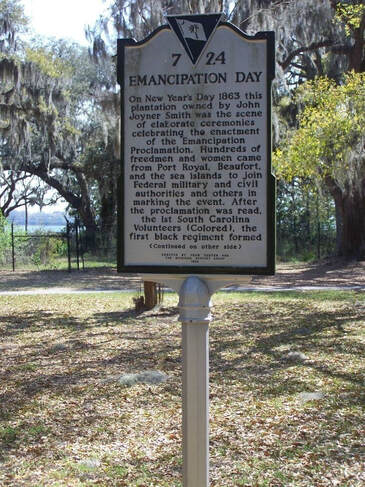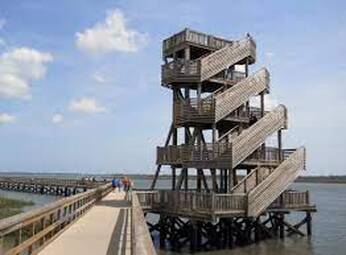the first to be free
|
Hist. marker at port Royal, SC.

Historical depiction of Emancipation Day.
African Americans visitors pay tribute at the site.
|
The Flora, a small steamer, paddled toward landfall where a grove of live oaks stood on a point overlooking the Beaufort River. It was January 1, 1863, a bright day, unseasonably warm.
“We enjoyed perfectly the exciting scene on board the Flora,” wrote Charlotte Forten, a missionary teacher, in an article for Atlantic Magazine. “There was an eager, wondering crowd of freed people in their holiday attire with the gayest of head-handkerchiefs, the whitest of aprons, and the happiest of faces. The band was playing, the flags streaming, everybody talking merrily.” The little steamship was en route to the Smith plantation, which had been transformed into a U.S. Army camp. On that mild winter day nearly 150 years ago, thousands would gather to hear President Abraham Lincoln’s Emancipation Proclamation read publicly for the first time in South Carolina. The former slaves of Port Royal would officially become freed people once the president in Washington signed the proclamation that evening. Forten, in her diary, called it “the most glorious day this nation has yet seen.” At age 25, Forten was the first black missionary to arrive in Port Royal after Union forces overwhelmed Confederate defenses in November 1861. Cotton planters and their families fled to the mainland, but most of the slaves—nearly 10,000—stayed behind to welcome Union soldiers. Port Royal was the U.S. government’s name for the sea islands of Beaufort District (Beaufort County), a remote place of salt marshes, tidal rivers and creeks, and low-elevation lands of deep woods and productive cotton plantations. |
Things to do in POrt ROyal
Most Frequently Visited PagesRequest an International Invitation Letter
|
Contribute to OAV |
Website: http://www.oyotunji.org Email: [email protected] Hours of Operation: 11 a.m.- Dusk Location: 56 Bryant Lane Seabrook, SC 29940 |
OYOTUNJI.ORG





